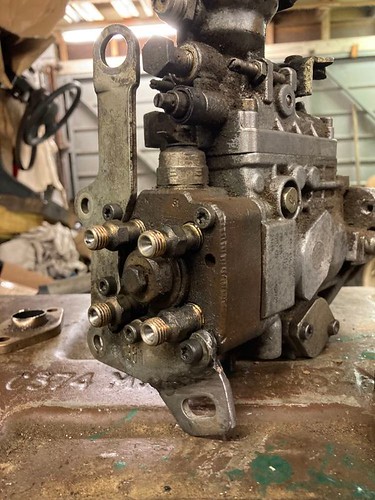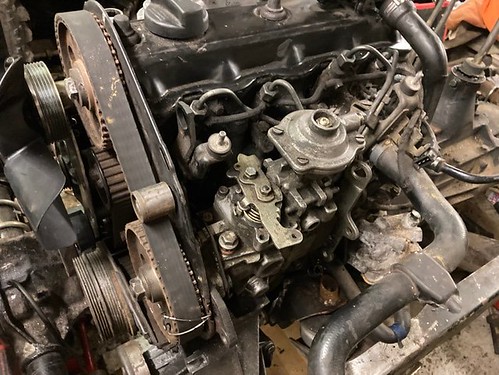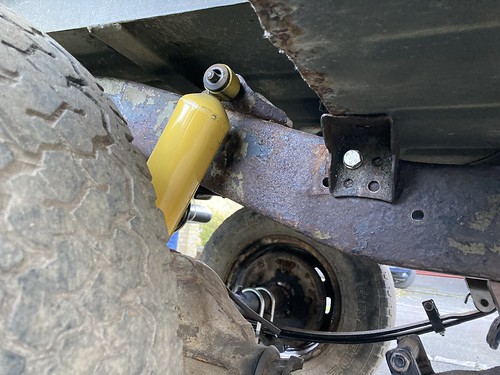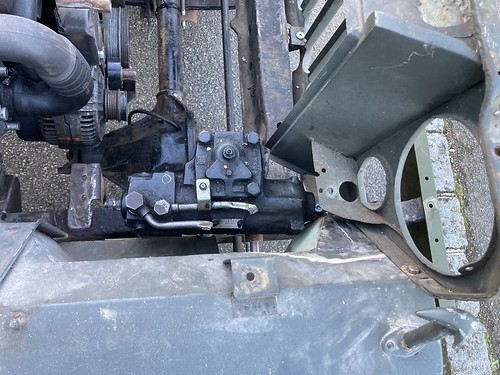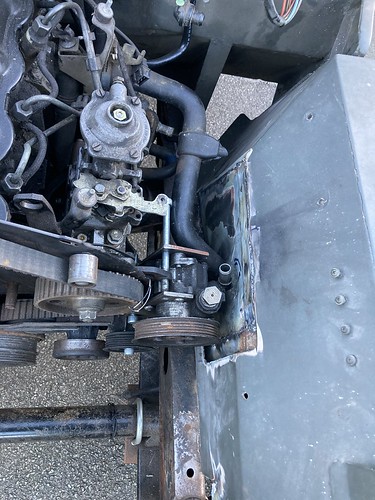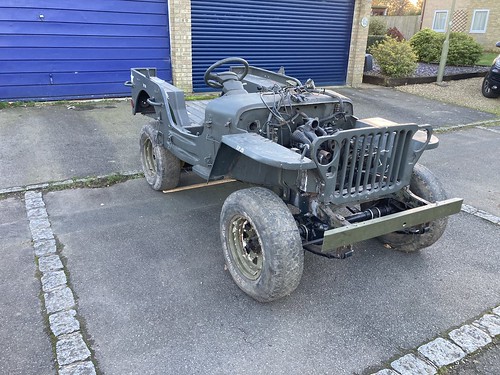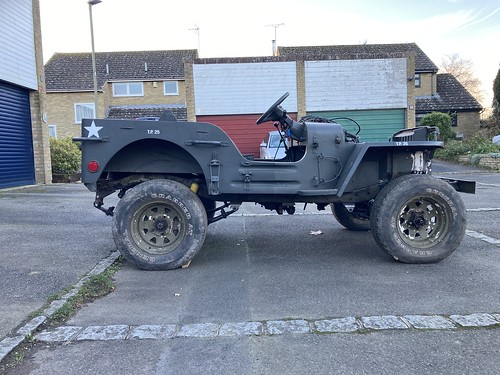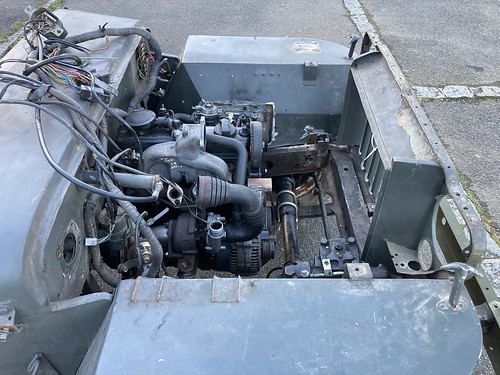Here we are again, with an update; it took a while, but I spent a lot of time to get to this point:
With the engine mounted, there are still a few things to sort out to make this engine work in the jeep. There are some serious clashing problems with the LH chassis rail to the oil filter, the alternator, the PAS pump and the viscous fan. Neither are of these are easily solvable, they are proper head on train crash stuff.
The Oil filter problem was solved by changing the filter for a shorter one, of a Vauxhall Omega V6; it is about half the length of the VW one, at the expense of a non-return valve and an overflow valve. It now clears the chassis rail with some distance:

And this is where the simple solutions ended: the other problems had to be solved by moving parts to other places. The alternator had to move to the RH side of the engine, in the space for the AC pump, and the PAS pump moved upwards to clear the chassis rail, and essentially in the position where it sits in the Golf. A bracket was made up soon enough for the PAS pump:
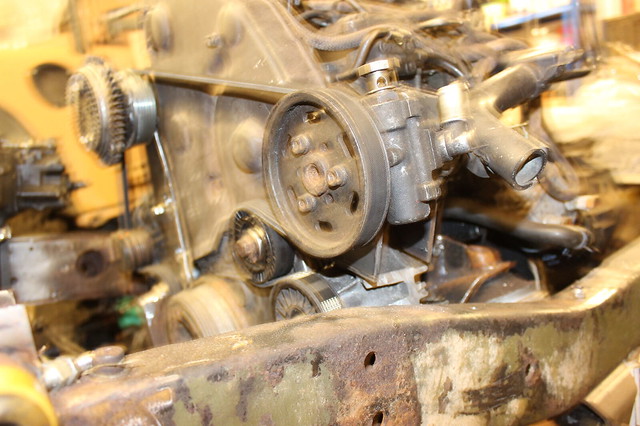
On the RH side a bracket was made up to hold the alternator, and I searched for ways to move the viscous fan as well. I much prefer the viscous over an electric fan for an off-road vehicle. All this then need some form of tensioner as well, since the original one now does not work in its position where it is. I essentially had to re-design the accessory drive, and this is where it went very quickly from ‘how hard can it be’ to the one problem that kept me awake at night. There is only one place where the tensioner can be, which is next to the crank pulley at the unloaded part of the belt. In this position, it also increases the belt wrap around the crank pulley and the alternator pulley. Several automotive tensioners were tried, but none of them looked like I could get to work. The clock spring is usually massive, and there just isn’t the space required. Then I looked at linear spring versions. The Mondeo MK3 diesel tensioner is the one I went with. The dimensions of the arm aren’t quite right, but I used the spring, the pulley and the bearings of this and fabricated my own version of tensioner arm:
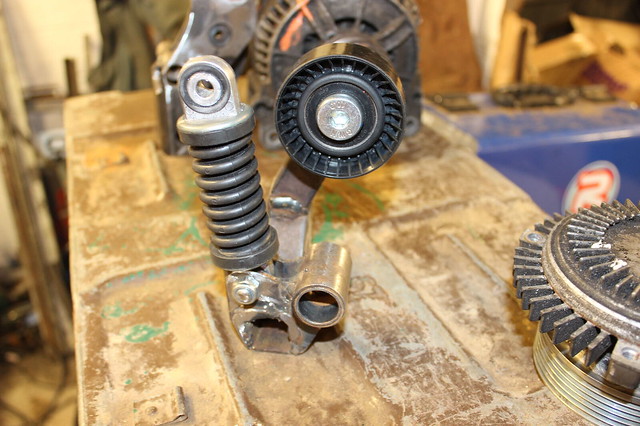
There were quite a few turned parts needed for this project, this I got done to my drawings by Darren at Bushes2U.com. His work was spot on, well recommended:
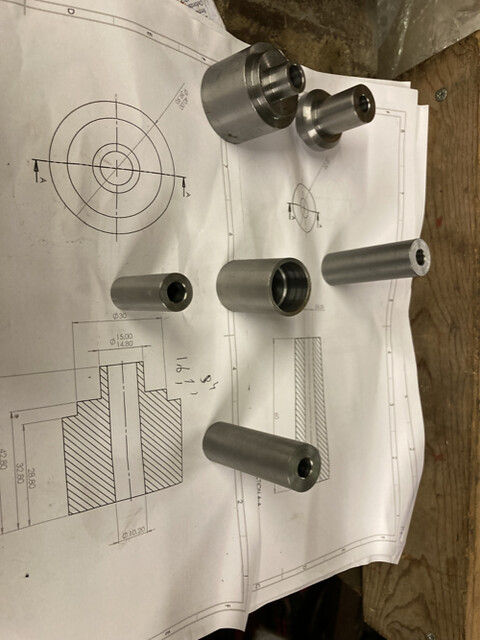
The alternator, tensioner and viscous fan bearing are all incorporated in this fabricated bracket:
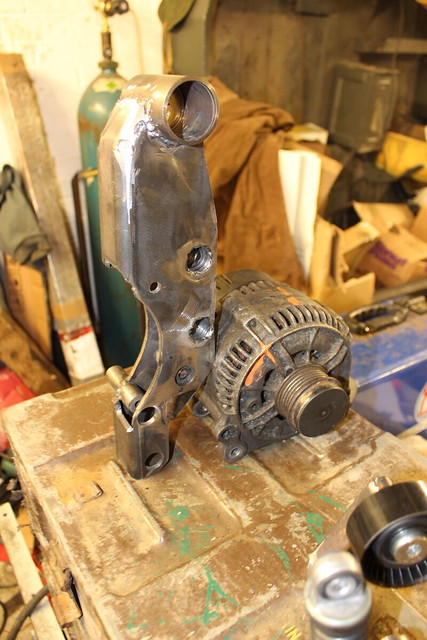
All assembled it looks like this:

Mounted to the engine:
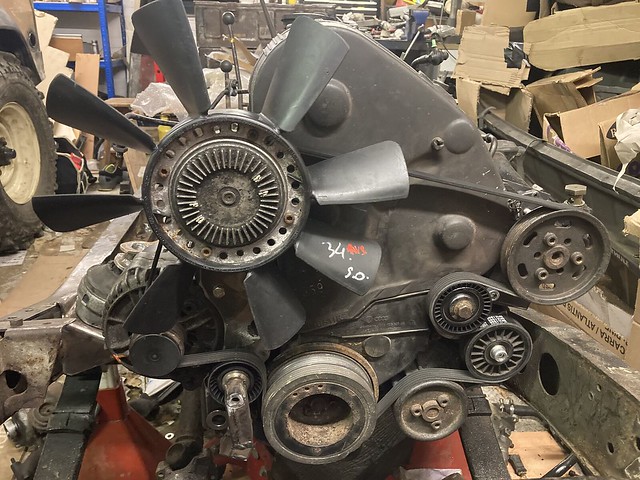
On the engine, anti clock wise from the crank pulley, there is the water pump pulley, an idler pulley (was the location of the viscous fan), another idler pulley (old tensioner, changed to a ribbed pulley), pas pump, and viscous fan shaft. The viscous fan used to be driven by the smooth side of the belt, but in this position, it gets driven by the ribbed side of the belt. This means 2 things; the pulley needs changing for a ribbed pulley, and the rotation is now the opposite way. I solved the ribbed pulley problem by using a Ford Fiesta ribbed pulley, welded to the old pulley and I swapped the fan for a version of the VW Passat with a petrol engine. This fan bolts on the diesel viscous coupling and is made to rotate the opposite way. A longer belt finished of the job.
Thanks for reading, thing are moving, but slowly!
Daan
With the engine mounted, there are still a few things to sort out to make this engine work in the jeep. There are some serious clashing problems with the LH chassis rail to the oil filter, the alternator, the PAS pump and the viscous fan. Neither are of these are easily solvable, they are proper head on train crash stuff.
The Oil filter problem was solved by changing the filter for a shorter one, of a Vauxhall Omega V6; it is about half the length of the VW one, at the expense of a non-return valve and an overflow valve. It now clears the chassis rail with some distance:

And this is where the simple solutions ended: the other problems had to be solved by moving parts to other places. The alternator had to move to the RH side of the engine, in the space for the AC pump, and the PAS pump moved upwards to clear the chassis rail, and essentially in the position where it sits in the Golf. A bracket was made up soon enough for the PAS pump:

On the RH side a bracket was made up to hold the alternator, and I searched for ways to move the viscous fan as well. I much prefer the viscous over an electric fan for an off-road vehicle. All this then need some form of tensioner as well, since the original one now does not work in its position where it is. I essentially had to re-design the accessory drive, and this is where it went very quickly from ‘how hard can it be’ to the one problem that kept me awake at night. There is only one place where the tensioner can be, which is next to the crank pulley at the unloaded part of the belt. In this position, it also increases the belt wrap around the crank pulley and the alternator pulley. Several automotive tensioners were tried, but none of them looked like I could get to work. The clock spring is usually massive, and there just isn’t the space required. Then I looked at linear spring versions. The Mondeo MK3 diesel tensioner is the one I went with. The dimensions of the arm aren’t quite right, but I used the spring, the pulley and the bearings of this and fabricated my own version of tensioner arm:

There were quite a few turned parts needed for this project, this I got done to my drawings by Darren at Bushes2U.com. His work was spot on, well recommended:

The alternator, tensioner and viscous fan bearing are all incorporated in this fabricated bracket:

All assembled it looks like this:

Mounted to the engine:

On the engine, anti clock wise from the crank pulley, there is the water pump pulley, an idler pulley (was the location of the viscous fan), another idler pulley (old tensioner, changed to a ribbed pulley), pas pump, and viscous fan shaft. The viscous fan used to be driven by the smooth side of the belt, but in this position, it gets driven by the ribbed side of the belt. This means 2 things; the pulley needs changing for a ribbed pulley, and the rotation is now the opposite way. I solved the ribbed pulley problem by using a Ford Fiesta ribbed pulley, welded to the old pulley and I swapped the fan for a version of the VW Passat with a petrol engine. This fan bolts on the diesel viscous coupling and is made to rotate the opposite way. A longer belt finished of the job.
Thanks for reading, thing are moving, but slowly!
Daan












